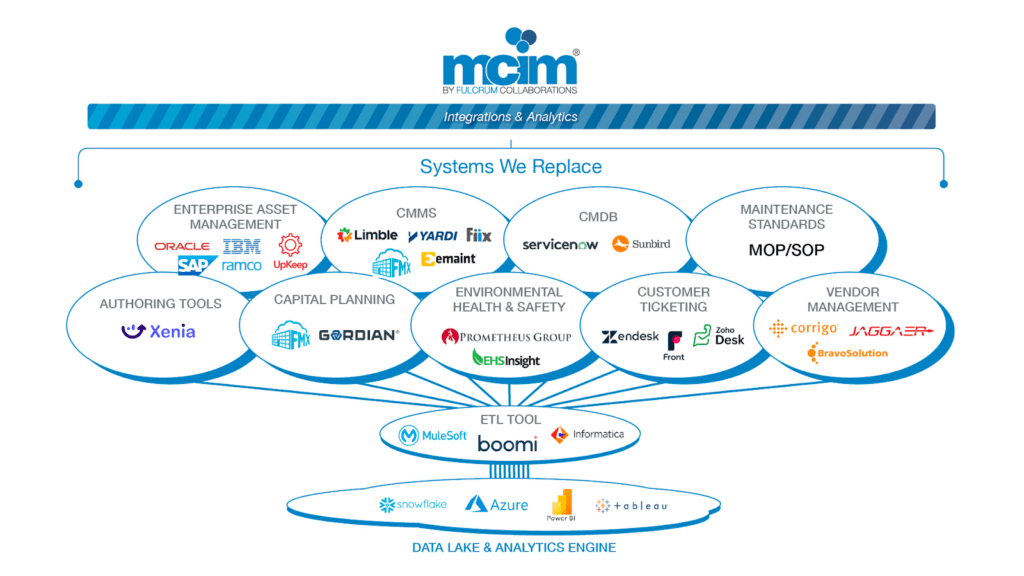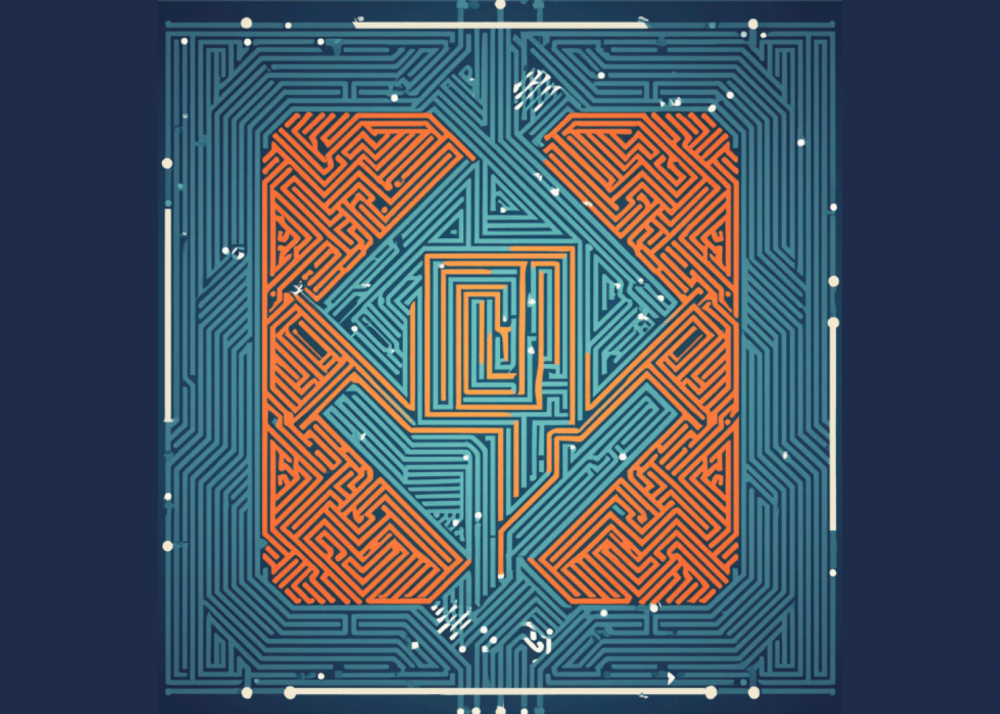Modern data centers depend on a complex web of systems to manage everything from asset lifecycles to compliance and security. While each system serves a purpose, their sheer volume often leads to inefficiencies, dirty data, rising costs, and elevated risk.
Let’s explore the current landscape of data center management systems, the hidden costs of system sprawl—and how MCIM offers a unified, cost-effective solution that redefines operational efficiency and reliability.
The Current Data Center Management Systems Landscape

Data centers use dozens of systems to perform specialized tasks. But without a unified platform, these tools often create operational silos and fragmented data. Here’s a look at just some of the systems in play:
Note: The list below is long but not comprehensive. Click here to skip ahead if you want to jump to the risks and costs of so employing so many different systems.
Enterprise Asset Management (EAM)
EAM systems act as the comprehensive database for all physical assets within an organization. These platforms track the lifecycle of assets from acquisition to disposal, including maintenance, upgrades, and depreciation. They help optimize the performance and utilization of assets, manage maintenance schedules, and ensure compliance with regulations. This level of management is crucial for maximizing the lifespan and value of a facility’s investments.
Computerized Maintenance Management Systems (CMMS)
CMMS software is designed to centralize maintenance information and streamline maintenance operations. It facilitates the tracking and scheduling of maintenance tasks, work order management, inventory control, and the documentation of maintenance procedures. CMMS tools are vital for enhancing maintenance efficiency, reducing downtime, and extending the life of machinery and equipment.
Building Management System (BMS)
A BMS controls and monitors a building’s mechanical and electrical systems. It operates heating, ventilation, air conditioning (HVAC), lighting, power systems, fire systems, and security functions. By automating these systems, a BMS ensures they operate together efficiently, maintaining optimal building conditions and reducing energy usage.
Enterprise Resource Planning (ERP)
ERP software integrates all facets of an operation, including product planning, development, manufacturing processes, human resources, financials, and sales and marketing. It serves as a central hub that facilitates the flow of information between all business functions inside the boundaries of the organization and manages the connections to outside stakeholders.
Rounds Monitoring System (RMS)
An RMS facilitates regular inspections of facility equipment and environmental conditions, guiding technicians through checkpoints to ensure operational integrity. It records real-time data for immediate issue resolution and compliance reporting, thereby preempting system failures and maintaining consistent facility performance.
Security Information and Event Management (SIEM)
SIEM systems provide a holistic view of an company’s information security. They aggregate and analyze log data from various sources, detect anomalies, and generate alerts for potential security incidents. By providing real-time analysis, SIEM systems are crucial for detecting, preventing, and responding to security threats.
Physical Security Systems
These systems encompass all the measures used to protect personnel, facilities, and resources from physical actions that could cause serious loss or damage. This includes access control systems to regulate entry to facilities, video surveillance systems for monitoring, intruder detection systems, and fire detection and response systems.
Network and IT Management Systems
These systems are used for the oversight and administration of a company’s IT infrastructure. They manage hardware, software, network policies, and compliance with standards. These systems ensure the operational integrity, security, and efficiency of an organization’s IT assets and services.
Environmental Monitoring Systems
The systems are made to constantly monitor the environment in a data center, including temperature, humidity, water leaks, and smoke. They help to maintain the proper environment for IT equipment operation, which is critical to minimize the risk of hardware failure due to environmental factors.
Configuration Management Database (CMDB)
A centralized repository that stores information about hardware and software assets (commonly referred to as Configuration Items or CIs), and their relationships. These systems help organizations understand the makeup of critical assets and their dependencies, which is vital for risk management, change management, and incident resolution.
Data Center Infrastructure Management (DCIM)
DCIM is primarily used for managing the Operational Technology (OT) components of a data center. It focuses on the physical infrastructure such as power, cooling, space, and environmentals, rather than IT assets like software applications, data storage, and network infrastructure. DCIM provides facility managers with tools to ensure their data center’s performance is optimized from an operational standpoint, which includes managing the use of energy, ensuring efficient use of space, and maintaining the right environmental conditions to keep hardware in good health.
Maintenance Standards Systems
This software governs the maintenance operations and standard operating procedures within a facility. It ensures that all maintenance tasks are performed according to industry or company-specific standards and that they are documented and tracked for auditing and continuous improvement purposes.
Authoring Tools
These tools are used for creating, editing, and managing documents and procedures, such as SOPs. They often include features for collaborative editing, version control, and publishing, ensuring that documentation is current and accessible to all relevant personnel.
Capital Planning Tools
These tools assist in the forecasting and management of capital expenditures. They allow for the analysis of investment requirements in infrastructure, prioritize spending based on business needs, and track the ROI of capital projects.
Environmental Health and Safety (EHS)
EHS systems help organizations comply with health and safety regulations by tracking and managing workplace risks, recording incidents, and ensuring that health and safety policies are followed. They are critical in maintaining the well-being of employees and the environment.
Customer Ticketing Systems
These systems manage customer interactions by tracking service requests and support tickets. They help ensure that customer issues are addressed in a timely and organized manner, improving customer service and support.
Vendor Management Systems
These systems streamline the process of managing and evaluating vendor performance. They typically include functionalities for contract management, performance analysis, and procurement processes, ensuring effective external partner management.
Extract, Transform, Load (ETL) Toolkits
ETL toolkits are used to gather data from different sources, convert it into a standardized format, and load it into a database, data warehouse, or data lake. This process is crucial for businesses that need to consolidate and utilize data from various systems.
Data Lake and Analytic Engines
Data lakes store vast quantities of raw data in its native format until it is needed. Analytic engines then process this data and perform complex analysis to derive insights. Companies like Snowflake and Tableau enable businesses to make data-driven decisions by visualizing data trends and patterns.
Carbon Accounting
A carbon accounting system tracks the greenhouse gas emissions associated with the facility’s operations. It aids in identifying key areas for carbon footprint reduction, supports reporting for regulatory compliance and sustainability initiatives, and helps in strategizing towards more environmentally responsible practices.
…and so many more.
The Cost of Complexity
Operating these diverse systems incurs significant costs. including:
- Licensing and Subscription Fees: Each system requires separate licensing, often with high subscription fees.
- Maintenance and Upgrades: Regular updates and maintenance for multiple systems increase operational costs.
- Data Storage and Management: Storing data across several platforms is not only costly but also complex.
- Siloed Data and Integration Challenges: Integrating data across these systems is cumbersome and can lead to inconsistencies and errors, often referred to as “dirty data.”
This complex weave of systems not only elevate costs but also complicate compliance, hinder productivity, and increase the risk of data breaches or operational failures.
In one recent audit of a Tier III data center, 65% of assets had incorrect or missing data.
Dirty data doesn’t just slow you down—it blocks you from implementing RCM strategies, predictive maintenance, and capital planning based on accurate insights.
How MCIM Simplifies the Data Center Management Ecosystem

MCIM can consolidate or eliminate the need for at least 70% of these systems.
Rather than stitching together a dozen legacy tools, MCIM delivers a single pane of glass for data center operations—spanning assets, incidents, maintenance, monitoring, assessments, capital planning, and more.
MCIM Delivers:
- Unified Operations: By consolidating functions of CMDB, DCIM, EHS, and more into a single platform, MCIM eliminates the silos that plague traditional setups.
- Reduced Costs: One integrated system means significantly lower licensing, maintenance, and storage costs.
- Clean, Unified Data Set: MCIM’s centralized data management ensures data integrity, reducing the risk of “dirty data” and improving decision-making accuracy.
- Enhanced Productivity: With less time spent on system management and data reconciliation, teams can focus on strategic tasks that add value.
One MCIM client reduced preventable incidents by 84% through automation and standardization.
Replace Complexity with Clarity
The complexity and cost associated with managing numerous specialized systems in mission-critical facilities can be overwhelming and risky. MCIM offers a powerful alternative by replacing these disparate systems with a single, comprehensive platform that reduces costs, simplifies operations, and ensures clean, reliable data.
MCIM is trusted by leading operators in financial services, telecommunications, and colocation—including 75% of top MTDCs and 80% of the top U.S. banks.
It’s not just a platform. It’s a rethink of what data center management should be: unified, proactive, intelligent, and scalable.
To speak with an expert and learn more about how MCIM can streamline your data center operations, click here.



